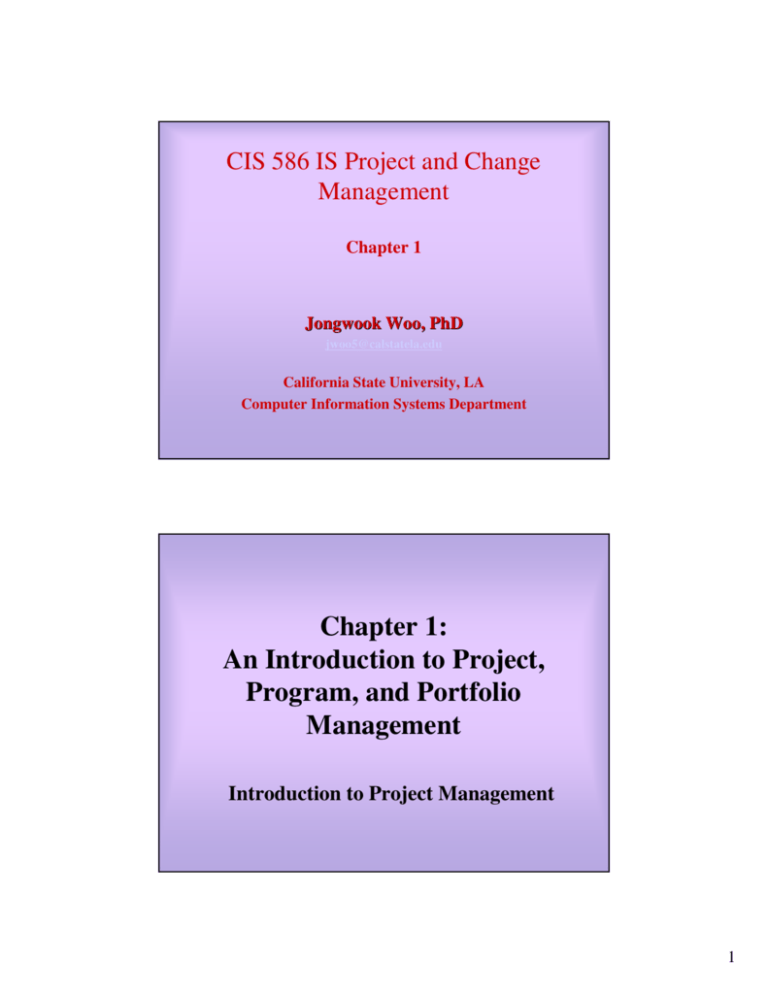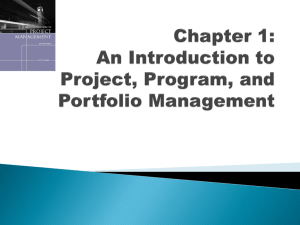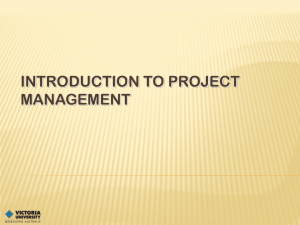An Introduction to Project, Program, and Portfolio Management
advertisement

CIS 586 IS Project and Change Management Chapter 1 Jongwook Woo, PhD jwoo5@calstatela.edu California State University, LA Computer Information Systems Department Chapter 1: An Introduction to Project, Program, and Portfolio Management Introduction to Project Management 1 Learning Objectives • • • Understand the growing need for better project, program, and portfolio management. Explain what a project is, provide examples of projects, list various attributes of projects, and discuss the triple constraint of project management. Describe project management and key elements of the project management framework, including project stakeholders, project management knowledge areas, common tools and techniques, and project success factors. Introduction to Project Management Copyright 2008 3 Learning Objectives (continued) • Discuss the relationship between project, program, and portfolio management and their contribution to enterprise success. • Describe the project management profession, including suggested skills for project, program, and portfolio managers, the role of professional organizations such as the Project Management Institute, the importance of certification and ethics, and the growth of project and portfolio management software. Introduction to Project Management Copyright 2008 4 2 Introduction • Many organizations today have a new or renewed interest in project management. – The U.S. spends $2.3 trillion on projects every year, or one-quarter of its gross domestic product, and the world as a whole spends nearly $10 trillion of its $40.7 gross product on projects of all kinds.* – In 2006, the average senior project manager in the U.S. earned over $104,000 per year.** – Project management certification is popular worldwide. *PMI, Inc., The PMI Project Management Fact Book, Second Edition, 2001. **PMI, Inc., Project Management Salary Survey, Fifth Edition, 2007. Introduction to Project Management Copyright 2008 5 What Went Wrong? • A 1995 Standish Group study (CHAOS) found that only 16.2 percent of information technology (IT) application development projects were successful in meeting scope, time, and cost goals. • Over 31 percent of the projects were canceled before completion, costing over $81 billion in the U.S. alone. • A 2004 PricewaterhouseCoopers study of 200 companies from 30 different countries found that over half of all projects fail. • The authors of this study were adamant about the need for better project management. Introduction to Project Management Copyright 2008 6 3 Advantages of Using Formal Project Management • Better control of financial, physical, and human resources • Improved customer relations • Shorter development times • Lower costs • Higher quality and increased reliability • Higher profit margins • Improved productivity • Better internal coordination • Higher worker morale Introduction to Project Management Copyright 2008 7 What Is a Project? • A project is “a temporary endeavor undertaken to create a unique product, service, or result.”* • Operations is work done to sustain the business. • Projects end when their objectives have been reached, or the project has been terminated. *Project Management Institute, Inc., A Guide to the Project Management Body of Knowledge (PMBOK® Guide) (2004), p. 5. Introduction to Project Management Copyright 2008 8 4 Examples of Projects • A young couple hires a firm to design and build them a new house. • A college campus upgrades its technology infrastructure to provide wireless Internet access. • A television network develops a system to allow viewers to vote for contestants and provide other feedback on programs. • A government group develops a program to track child immunizations. Introduction to Project Management Copyright 2008 9 Project Attributes • A project: – Has a unique purpose. – Is temporary. – Is developed using progressive elaboration or in an iterative fashion. – Requires resources, often from various areas. – Should have a primary customer or sponsor. • The project sponsor usually provides the direction and funding for the project. – Involves uncertainty. Introduction to Project Management Copyright 2008 10 5 Figure 1-1. Lost For Words A good project manager is crucial to a project’s success. Project managers work with the project sponsors, the project team, and the other people involved in a project to meet project goals. Introduction to Project Management Copyright 2008 11 The Triple Constraint • Every project is constrained in different ways by its: – Scope: What work will be done as part of the project? What unique product, service, or result does the customer or sponsor expect from the project? – Time: How long should it take to complete the project? What is the project’s schedule? – Cost: What should it cost to complete the project? What is the project’s budget? • It is the project manager’s duty to balance these three often competing goals. Introduction to Project Management Copyright 2008 12 6 Figure 1-2. The Triple Constraint of Project Management Introduction to Project Management Copyright 2008 13 More on the Triple Constraint • It may be good enough to hit the target, or range of triple constraint goals, but not the bull’s-eye. • It’s important to determine which aspects of the triple constraint are the most important. • The “quadruple constraint” includes quality as well as scope, time, and cost. Introduction to Project Management Copyright 2008 14 7 What is Project Management? • Project management is “the application of knowledge, skills, tools and techniques to project activities to meet project requirements.”* *Project Management Institute, Inc., A Guide to the Project Management Body of Knowledge (PMBOK® Guide) (2004), p. 8. Introduction to Project Management Copyright 2008 15 Figure 1-3. Project Management Framework Introduction to Project Management Copyright 2008 16 8 Project Stakeholders • Stakeholders are the people involved in or affected by project activities. • Stakeholders include: – – – – – – – The project sponsor The project manager The project team Support staff Customers Suppliers Opponents to the project Introduction to Project Management Copyright 2008 17 Project Management Knowledge Areas • Four core knowledge areas lead to specific project objectives. – Project scope management involves defining and managing all the work required to complete the project successfully. – Project time management includes estimating how long it will take to complete the work, developing an acceptable project schedule, and ensuring timely completion of the project. – Project cost management consists of preparing and managing the budget for the project. – Project quality management ensures that the project will satisfy the stated or implied needs for which it was undertaken. Introduction to Project Management Copyright 2008 18 9 Project Management Knowledge Areas (continued) • Four facilitating knowledge areas are the means through which the project objectives are achieved. – Project human resource management is concerned with making effective use of the people involved with the project. – Project communications management involves generating, collecting, disseminating, and storing project information. – Project risk management includes identifying, analyzing, and responding to risks related to the project. – Project procurement management involves acquiring or procuring goods and services for a project from outside the performing organization. • One knowledge area (project integration management) affects and is affected by all of the other knowledge areas. • All knowledge areas are important! Introduction to Project Management Copyright 2008 19 Project Management Tools and Techniques • Project management tools and techniques assist project managers and their teams in various aspects of project management. • Note that a tool or technique is more than just a software package. • Specific tools and techniques include: – Project charters, scope statements, and WBS (scope) – Gantt charts, network diagrams, critical path analyses (time) – Net present value, cost estimates, and earned value management (cost) – See Figure 1-4 for more examples Introduction to Project Management Copyright 2008 20 10 Introduction to Project Management Copyright 2008 21 Introduction to Project Management Copyright 2008 22 11 • “Super tools” are those tools that have high use and high potential for improving project success, such as: – Software for task scheduling (such as project management software) – Scope statements – Requirements analyses – Lessons-learned reports • Tools already extensively used that have been found to improve project importance include: – Progress reports – Kick-off meetings – Gantt charts – Change requests Introduction to Project Management Copyright 2008 23 What Went Right? Improved Project Performance* The Standish Group’s CHAOS studies show improvements in IT projects in the past decade Measure Successful Projects Failed Projects Money wasted on failed and challenged projects 1994 Data 16% 31% $140B out of $250B or 56% 2006 Data 35% 19% $53B out of $346B or 15% Result More than doubled Almost halved Well more than halved *Jim Johnson, “CHAOS 2006 Research Project,” CHAOS Activity News, vol. 2: issue 1, (2007). Introduction to Project Management Copyright 2008 24 12 Why the Improvements? “The reasons for the increase in successful projects vary. First, the average cost of a project has been more than cut in half. Better tools have been created to monitor and control progress and better skilled project managers with better management processes are being used. The fact that there are processes is significant in itself.”* *The Standish Group, “CHAOS 2001: A Recipe for Success” (2001). Introduction to Project Management Copyright 2008 25 Project Success • There are different ways to define project success: – The project met scope, time, and cost goals. – The project satisfied the customer/sponsor. – The project produced the desired results. Introduction to Project Management Copyright 2008 26 13 What is a Program? • A program is: – “a group of related projects managed in a coordinated way to obtain benefits and control not available from managing them individually.”* – A program manager provides leadership and direction for the project managers heading the projects within the program. *Project Management Institute, Inc., A Guide to the Project Management Body of Knowledge (PMBOK® Guide) (2004), p. 8. Introduction to Project Management Copyright 2008 27 Project Portfolio Management • Project portfolio management is an emerging business strategy in which organizations group and manage projects and programs as a portfolio of investments that contribute to the entire enterprise’s success. • Pacific Edge Software’s product manager, Eric Burke, defines project portfolio management as “the continuous process of selecting and managing the optimum set of project initiatives that deliver maximum business value.”* *Eric Burke, “Project Portfolio Management,” PMI Houston Chapter Meeting (July 10, 2002). Introduction to Project Management Copyright 2008 28 14 Introduction to Project Management Copyright 2008 29 The Project Management Profession • Project, program, and portfolio managers need to develop specific skills. • Certification is available for project managers. • There are many software tools to assist in project, program, and portfolio management. Introduction to Project Management Copyright 2008 30 15 Suggested Skills for Project Managers Knowledge of the following: • All nine project management knowledge areas • The application area, including specific standards and regulations • The project environment • General management • Human relations Introduction to Project Management Copyright 2008 31 Media Snapshot – Good Project Management Skills from The Apprentice • • • • • Leadership and professionalism are crucial. Know what your sponsor expects from the project, and learn from your mistakes. Trust your team, and delegate decisions. Know the business. Stand up for yourself. Introduction to Project Management • • • • • Be a team player. Don’t be overly emotional and stay organized. Work on projects and for people you believe in. Think outside of the box. Some luck is involved in project management, and you should always aim high. Copyright 2008 32 16 Introduction to Project Management Copyright 2008 33 Importance of Leadership Skills • Effective project managers provide leadership by example. • A leader focuses on long-term goals and big-picture objectives while inspiring people to reach those goals. • A manager deals with the day-to-day details of meeting specific goals. • Project managers often take on the role of both leader and manager. Introduction to Project Management Copyright 2008 34 17 Introduction to Project Management Copyright 2008 35 • Large projects: leadership, people skills, – relevant prior experience, planning, verbal communication, and team-building skills are most important • High uncertainty projects: leadership, people skills, – risk management, expectation management, and planning skills are most important • Very novel projects: leadership, people skills, – having vision and goals, self-confidence, expectations management, and listening skills are most important Introduction to Project Management Copyright 2008 36 18 Additional Skills for Program and Portfolio Managers • Program managers normally have experience as project managers. They often rely on their past experience, strong business knowledge, leadership capability, and communication skills to manage programs. • Portfolio managers must have strong financial and analytical skills and understand how projects and programs can contribute to meeting strategic goals. Introduction to Project Management Copyright 2008 37 A best practice is “an optimal way recognized by industry to achieve a stated goal or objective.”* Robert Butrick suggests that organizations need to follow basic principles of project management, including these two mentioned earlier in this chapter: Make sure your projects are driven by your strategy. Be able to demonstrate how each project you undertake fits your business strategy, and screen out unwanted projects as soon as possible. Engage your stakeholders. Ignoring stakeholders often leads to project failure. Be sure to engage stakeholders at all stages of a project, and encourage teamwork and commitment at all times. *Project Managementand Institute, Organizational to Project Maturity Model (OPM3) Use leadership open Inc., communications makeManagement things happen.** Knowledge Foundation (2003), p. 13. **Ultimate Business Library, Best Practice: Ideas and Insights from the World’s Foremost Business Thinkers, Perseus Publishing (2003). Introduction to Project Management Copyright 2008 38 19 Project Management Certification • PMI provides certification as a Project Management Professional (PMP). • A PMP has documented sufficient project experience, agreed to follow a code of ethics, and passed the PMP exam. • The number of people earning PMP certification is increasing quickly. Introduction to Project Management Copyright 2008 39 Introduction to Project Management Copyright 2008 40 20 Ethics in Project Management • Ethics – a set of principles that guide our decision making based on personal values of what is “right” and “wrong” – is an important part of all professions. • Project managers often face ethical dilemmas. • In order to earn PMP certification, applicants must agree to the PMP code of professional conduct. • Several questions on the PMP exam are related to professional responsibility, including ethics. Introduction to Project Management Copyright 2008 41 Project Management Software • There are hundreds of different products available today. • Three main categories of tools are the following: – Low-end tools: Handle single or smaller projects well; cost under $200 per user. – Midrange tools: Handle multiple projects and users; cost $200-600 per user; MS Project 2007 is the most popular (this text includes a trial copy). – High-end tools: Also called enterprise project management software; often licensed on a per-user basis; example is VPMi Enterprise Online (www.vcsonline.com); see front cover for trial version information. • Project 2007 includes a standard and an enterprise version. See the Guide to Using Microsoft Project 2007 on the companion Web site for details. Introduction to Project Management Copyright 2008 42 21 Introduction to Project Management Copyright 2008 43 Introduction to Project Management Copyright 2008 44 22 Chapter Summary • A project is a temporary endeavor undertaken to create a unique product, service, or result. • Project management is the application of knowledge, skills, tools, and techniques to project activities to meet project requirements. • A program is a group of related projects managed in a coordinated way to obtain benefits and control not available from managing them individually. • Project portfolio management involves organizing and managing projects and programs as a portfolio of investments that contribute to the entire enterprise’s success. • The project management profession continues to grow and mature. Introduction to Project Management Copyright 2008 45 23










